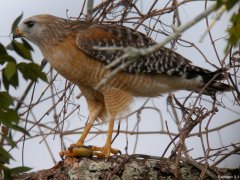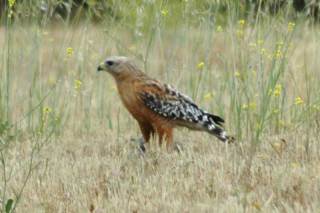Yes, I know it’s more of a bird of the day than a word of the day, but bear with me. My recent post about raindrops led me to venture into the realm of the compound word. With any such venture comes the inevitable discussion of the hyphen. And hyphens are a real bugaboo in bird names, as any birder can tell you. Audubon, for example, spelled Sturnella magna‘s common name with a hyphen: “Meadow-lark.” We know it as “Eastern Meadowlark.” In this instance, the dropping of the hyphen seems to be a result of overwhelming popular usage over the years. In other cases, though, the dropping of the hyphen is mandated by the rules of the international body that is seeking, perhaps quixotically, to standardize the English names of the 10,000+ species of world birds: the International Ornithological Congress (confusingly also known as the International Ornithological Committee).
Their rules state, for example, that since the Meadow-lark is not a lark, nor is it in the lark family, the hyphen should be deleted and the word closed up, to avoid confusion. That is, if a bird name is a compound. it should be spelled as one word
if the second word is a kind of bird (e.g., Nighthawk, Bushtit, Waterthrush, Meadowlark). but the taxon is not a member of the bird family named.
So, for instance, the funky birds formerly known as Cuckoo-Shrikes should now be called Cuckooshrikes, because they are neither cuckoos nor shrikes:
A Meadowlark is not a Lark; a Cuckooshrike is not a Shrike. Thus the name cannot be spelled as two words without a hyphen (e.g., Meadow Lark), or spelled with a hyphen followed by a capital letter (e.g., Cuckoo-Shrike).
(Actually, it doesn’t matter if the bird name in the first word isn’t accurate; the rule only cares about the bird name in the second word.) Now remember, right now we’re only dealing with compounds where the second word is a bird name; there are entirely different rules governing descriptive adjectives placed before the noun (whether the noun is compound or not makes no difference).
Another part of the convention is to use initial capitals. That is, one capitalizes the first letter of the word: easy-peasy if the name is simple, like Robin, or, to use a New World thrush, American Robin. But, if the name is compound, and therefore perhaps hyphenated, it starts to get a little complex. Standard editorial practice (that is, unconcerned with matters taxonomic) required hyphenated words in “initial caps” style to hyphenate only the first word, not the second. That is, if the compound is hyphenated one DOES NOT CAPITALIZE* the first letter after the hyphen.
Actually, it’s quite a bit more complicated than that. Here is the CMS rule for capitalization in headline style with hyphenated words:
8.169 Hyphenation: the simple rule. Capitalize only the first element unless any subsequent element is a proper noun or adjective.
8.170 Hyphenation: the more traditional rules. (1) Always capitalize the first element. (2) Capitalize any subsequent elements unless they are articles, prepositions, coordinating conjunctions (and, but, for, or, nor) or such modifiers as flat or sharp following musical key symbols. (3) If the first element is merely a prefix or combining form that could not stand by itself as a word (anti, pre, etc.), do not capitalize the second element unless it is a proper noun or proper adjective. (4) Do not capitalize the second element in a hyphenated spelled-out number (twenty-one, etc.). (5) Break a rule when it doesn’t work.
Hence, according to both the simple and the complex rules CMS supplies, and according to the IOC’s name list, Buteo lineatus lineatus (Gmelin, 1788) is Red-shouldered Hawk, not Red-Shouldered Hawk.
Below are the complete brief rules adopted by the IOC:
- Official English names of birds are capitalized, as is the current practice in ornithology (e.g., Yellow-throated Warbler).
- Patronyms are used in the possessive case (e.g., Smith’s, Ross’s).
- Names on this list do not include diacritical marks.
- There are compromises between British and American spellings in this list.
- Those who adopt the list should spell and add pronunciation marks as preferred.
- Geographical words in a name may be in noun or adjective form but must be consistent for that location (e.g., Canada , not Canadian).
- Compound words conform to a series of rules that consistently address relationships between the two words and readability.
- Use of hyphens in compound group names to indicate relationships among species is minimized, contrary to Parkes (1978).
- Hyphens are used in compound names only to connect two names that are birds or bird families (e.g., Eagle-Owl, Flycatcher-shrike) or when the name would be otherwise difficult to read (e.g., Silky-flycatcher, White-eye).
There are, though, odd exceptions, like Eagle-Owl, which is spelled hyphenated because it would be hard to pronounce at first glance without hyphenation (Eagleowl), and the Owl is capitalized because, well, I’m not sure why. If you try arguing from the CMS rules above that Owl is capitalized because it’s a proper noun, I’ll give you a funny look (or an emoticon expressing amazement, like so: :^0 ) and ask you if you know what a proper noun is. If you say that it’s capitalized because an Eagle-Owl is an owl, well, duh. But then, what about other hyphenated forms, like shrike in Flycatcher-shrike, or flycatcher in Silky-flycatcher which aren’t capitalized? Ah, the comittee thought of that too:
• Where both nouns are the names of birds or bird families a hyphen should be inserted to signify that the taxon belongs to the family of the second word, not the first (e.g., Eagle-Owl, Nightingale-Thrush). This conforms to correct English use of hyphens.
• If a name is of a taxon that is not a member of the stated bird family, the letter after the hyphen should be lowercase to clarify that status (e.g., Flycatcher-shrike). This is a companion to the rule, described above, applicable to single-word names that hyphenates them to avoid confusion, as in Silky-flycatcher or Stone-curlew.
Flycatcher-shrikes aren’t shrikes; Silky-flycatchers aren’t flycatchers.
Anyway, who really cares? Let’s get back to our FLWOD, Red-shouldered Hawk. Here is a picture of one we found out at the Loxahatchee NWR in December, 2008:
As you can see by the patches on the shoulders, its common name applies fairly well. And as you can see by the horizontal barring on the flanks, the scientific name (Buteo lineatus) applies pretty well also. Buteos are the most abundant hawks in North America, with broad wings (one member of the genus. B. platypterus, is called Broad-winged Hawk, although its wings are not particularly broader than its congeners), and a robust, powerful body. (Buteos, by the way, are called buzzards in the Old World, which confuses the heck out of people here in the New World who think of vultures as buzzards.)
The “Florida” Red-shouldered Hawk is B. lineatus alleni, named by Ridgway back in 1884. According to Arthur Cleveland Bent, whose Life Histories of North American Birds series was THE reference tool of the 20th century:
In Florida it is decidedly the commonest hawk and quite evenly distributed in all kinds of timbered regions; it seems to be equally at home in the extensive flat pine woods and in the dense live-oak hammocks. It is much more abundant than hawks are elsewhere, is quite tame and conspicuous, and, during the breeding season, very noisy. It seems to be less of a forest bird and is oftener seen in open country than is its northern relative. It is most abundant in regions like the Kissimmee Prairie, where wide open prairies or savannas are dotted with small hammocks of live oaks and palmettos. In the flat pine woods it is more widely scattered and seems to prefer the smaller tracts or the vicinity of small cypress swamps. (200)
That paragraph, published in 1937, can stand today with only one minor modification: I would delete the word “extensive” in the first sentence. Most of Florida’s flat pine woods are gone now, victims of our understandable desire to build homes in areas that are reasonably easy to clear and relatively high and dry. (I say relatively, because many pinewoods in Florida are seasonally flooded.)
The canonical FL reference book, Stevenson & Anderson’s Birdlife of Florida adds:
The Red-shouldered Hawk inhabits swamps, river floodplains, moist woodlands, and hammocks. It forages both above and below the canopy, locating prey from the air or a perch in a tree. It also hunts at the woodland’s edge, drainage canals, and marshes and often perches on a fence, utility pole, or wire along the road-side. The Red-shouldered usually flies directly to seize its prey. It eats rodents and other small mammals, as well as frogs, toads, and a variety of insects. Birds make up only a small portion of its diet. (165)
Now the bird pictured is a B. lineatus alleni, Florida Red-shouldered Hawk, not one of the many northern birds that join “our” birds for the winter. Ridgway describes Florida’s RSHA in comparison to the northern form thusly:
smaller than B. lineatus, the adult much paler in color, with no rufous on upper parts, except on lesser wing-coverts; the young decidedly darker than in true lineatus…. The very decidedly ashy coloration of the upper parts relieved only by fine shaft-lines of black on the head and neck, dusky clouding on the back, and white streaking on the occiput, combined with the pale coloration of the lower parts, serves readily to distinguish this race from the true B. lineatus. (Bent, 199)
Ridgway, of course, was practicing shotgun ornithology, describing minute plumage details seen best on a bird in the hand. I can’t see much of this bird’s back, but it sure looks like the bird has a much paler head than, say, this California RSHA:
Sorry about the poor autofocus on this bird; the weeds in the foreground confused the sensors in my non-VR non-prime 70-300 lens. Sigh. If you want better pictures to compare B. lineatus lineatus to B. lineatus alleni, try Cornell’s site.
At all events, the Red-shouldered Hawk is one of the coolest birds in Florida. Hope you enjoy it!
*It’s irony. Get it? Spelling in all caps the very words that tell you not to use capital letters? Get it? Get it?



Beautiful bird, informative blog!
I’ve not run into the word patronym before and find it a little humorous that OF COURSE the last names used to signify a bird can only be bestowed by a male 😉
Lots of Red-tailed Hawks in my native Ohio and here in Colorado too. Last month a local man got this excellent shot of a Kingbird riding a hawk (warning: the Post obviously didn’t refer to style manuals on these matters).
That photo also reminded me of an older series of the same behavior.
Thanks for the link to the photos; I’d never seen them before! Amazing!
And thanks for picking up on “patronym”; I’m actually developing another post to address the issue.